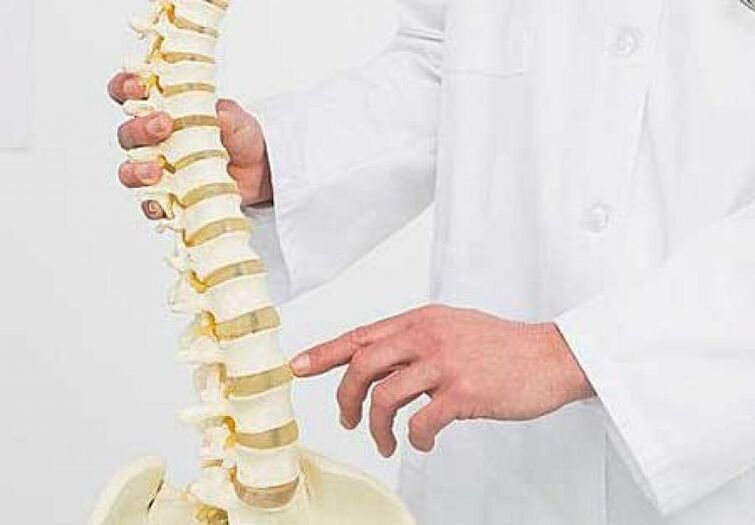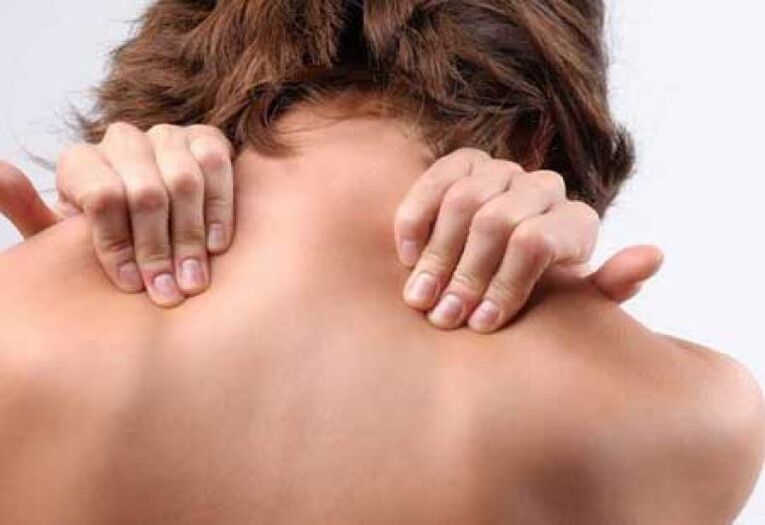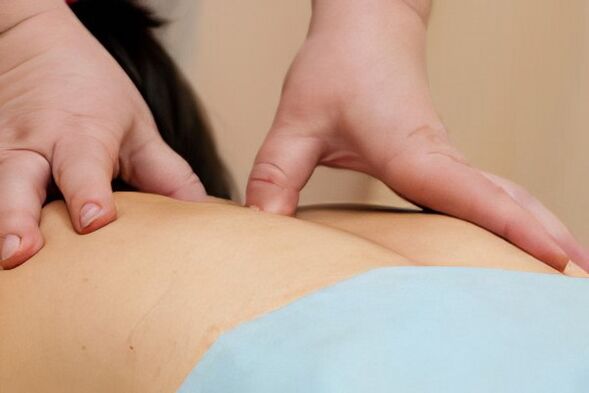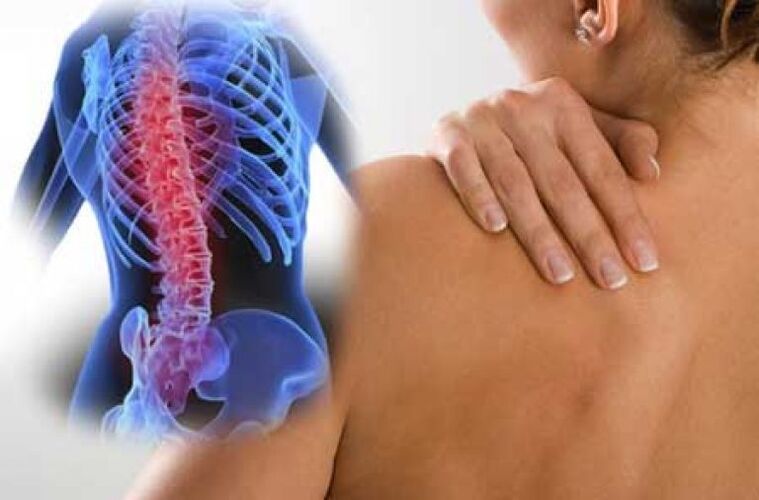With osteonecrosis, the bones and cartilage tissue of the cervical, lumbar, or thoracic vertebrae are affected. Pathology often leads to disability and in advanced cases, for example, with the formation of a herniated disc, surgical intervention is required. We will describe in detail thoracic osteonecrosis, its symptoms, and its treatment in this document.
Thoracic fibroma - what is it?
Thoracic osteochondrosis are degenerative-dystrophic changes in the vertebrae of the thoracic spine with destruction of joints, discs and cartilage. Compared to the neck and lumbar region, the chest area is not as mobile and because of the connection with the ribs, it is more durable.

As a result, it is less affected by external influences. However, with sedentary work, weak spinal muscles, and injuries, the risk of osteosarcoma in the thoracic spine is very high.
The risk factors are:
- high load on the back - lifting weights, pregnancy, wearing high heels, flat feet;
- sedentary lifestyle;
- rachiocampsis;
- backache;
- incorrect posture;
- genetic predisposition;
- nervous tension.
The development of osteochondrosis of the thoracic cavity leads to thinning of the intervertebral discs, the appearance of disc herniation, wear of the meniscus of the spinal joints, the pathological development of bone tissue, the growth of masses. grow outward - bone-forming cells are formed on it.
As a result of such changes, compression of blood vessels and nerve fibers, damage to the spinal cord (myocardial ischemia, myelopathy) can occur. Another serious complication of the disease is a herniated disc.
Symptoms of thoracic osteonecrosis, photo

With osteochondrosis of the thoracic spine, symptoms often appear and are aggravated under load, with abrupt movements, e. g. rotation of the torso, tilting.
It can be a dull ache or aching pain that appears between the shoulder blades, accompanied by a feeling of tightness in the chest. If the lower ribs are displaced, then there is posterior limb syndrome, when a sharp pain is felt in the collarbone and lower chest.
When probing the spine in the affected vertebrae, you will feel pain locally - at the site of contact.
Compression of nerve fibers causes symptoms such as decreased sensitivity at the ends of the pinched nerves, changes in tendon reflexes (knees and heels).

There may be malfunctions in the functioning of internal organs, since the nerve roots located in the vertebrae of the chest region are responsible for the function of the liver, heart, kidneys, lungs, pancreas and intestines.
Other possible manifestations of osteonecrosis are sexual dysfunction, dyspnea, as well as localized pain in the area:
- mammary glands;
- chest and heart;
- hypochondrium - left or right;
- stomach and intestines;
- esophagus and pharynx.
Osteoma in the thoracic vertebrae is manifested by two types of pain:
- Dorsago - a sharp, penetrating, sharp pain between the shoulder blades and ribs, aggravated when trying to turn the body or change the position of the body. This symptom occurs during exacerbations of the disease.
- Back pain - comes on gradually and lasts 1-3 weeks. Dull pain, not manifest and localized in the thoracic spine, intensity increases when breathing deeply, leaning. I am accompanied by muscle spasms above and below the pain area, a feeling of lack of air.
Back pain is often worse at night and when the body is in one position for long periods of time.
What to do in an exacerbation of thoracic osteonecrosis?

An exacerbation of osteonecrosis can cause physical overload (playing sports, strenuous work), hypothermia, severe stress or fatigue, and heavy lifting. Acute pain may be accompanied by:
- headache, reminiscent of migraine attacks;
- nausea;
- dizzy;
- Severe weakness;
- loss of mobility;
- Rapidly breath.
The low back pain that occurs in the acute exacerbation of degenerative thoracic spine disease is difficult to resolve on its own. You should not choose a pain reliever without first seeing a specialist, as self-medication can cause serious complications.
The first course of action in case of acute pain is to call an ambulance or contact a neurologist. With a person's exacerbation, they are hospitalized, and in the hospital, they eliminate the pain syndrome and control the condition further. To relieve pain, analgesics and local anesthetics (injections, tablets, ointments) are used.
General therapeutic measuresand regulations on the aggravation stage are as follows:
- compliance with bed rest and minimal activity;
- take only medicines prescribed by your doctor;
- physiotherapy and light self-massage;
- physical therapy;
- balancing diet.
If the low back pain is caused by a herniated disc, then medication, wearing a bra, physical therapy, and for large cases, surgery is the only treatment. It is done after a thorough diagnosis and exclusion of other conditions with similar symptoms.
Strategies to treat thoracic osteonecrosis
With thoracic lesions, as in the case of osteonecrosis of the cervical spine, treatment is symptomatic. Among the prescribed drugs:
- Non-steroidal anti-inflammatory drugs;
- Pain relievers, which may also belong to the NSAID class;
- Local analgesics in the form of gels, creams, ointments and patches;
- Muscle relaxants for back muscle spasms;
- Vitamin and mineral complex helps to restore ligaments and bone tissue;
- Antidepressants.
An important component of the treatment are chondroprotectors - preparations based on glucosamine or chondroitin - they contribute to the restoration of cartilage tissue and are taken for a long time, in courses of six months or more.
The most effective means, including these two compounds.
AddMethods of treatment of thoracic osteosarcoma:
- physiotherapy - shock wave, laser, magnetic, ultraviolet exposure, electrophoresis;
- physical therapy;
- massage has a warming effect, increases metabolism in vertebral and joint tissues, reduces muscle tone;
- acupuncture - acupuncture;
- acupressure - tactile impact on biological acupuncture points;
- healthy food.

With osteochondrosis of the thoracic spine, therapeutic exercises are performed 2-3 times per day. The exercise program is compiled by the attending physician individually. Gymnastics is both preventable and treatable, designed to strengthen the spine and shoulder muscles, restore the natural curves of the spine, and help shape posture.
You can start doing it only after overcoming the pain syndrome. All exercises basically have movements that are reminiscent of the ones a person does in everyday life, so the muscles gradually strengthen during the workout without too much effort. level.
Prevention of thoracic osteonecrosis
The nature of the profession often facilitates the development of osteonecrosis. It's important for people who do heavy manual labor or sit all day at work to monitor their posture and regularly perform back-strengthening exercises.
Warm-ups several times a day as well as self-massage are helpful.
To prevent osteochondrosis of the thoracic spine, excess salt, sugar, spices, sweetened carbonated drinks, spicy and fried foods should be excluded from the diet.
Prefer natural foods without preservatives and dyes, vegetables, fruits, whole grains and other grains, lean meat and fish, dairy products, enough water. It is necessary to maintain a normal weight, do not forget to exercise moderately and do not abuse coffee and alcoholic beverages.
The position of the body during sleep is important - you should sleep on your back when sleeping on a dense hard mattress. The initial discomfort will disappear as soon as the vertebrae are back in place.
Compliance with all the preventive recommendations will allow the back to be strong, beautiful and live without pain.

















































